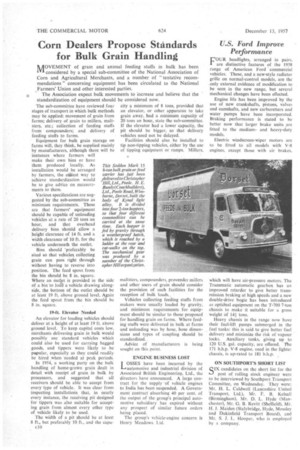Corn Dealers Propose Standards for Bulk Grain Handling
Page 52

If you've noticed an error in this article please click here to report it so we can fix it.
MOVEMENT of grain and animal feeding stuffs in bulk has been considered by a special sub-committee of the National Association of Corn and Agricultural Merchants, and a number of "tentative recommendations" concerning equipment has been circulated to the National .Farmers' Union and other interested parties.
The Association expect bulk movements to increase and believe that the standardization of equipment should be considered now.
The sub-committee have reviewed four stages of transport in which bulk methods may be applied: movement of grain from farms; delivery of grain to millers, maltsters. etc.; collection of feeding stuffs from compounders; and delivery of feeding stuffs to farms.
Equipment for bulk grain storage on farms will, they think, he supplied mainly by manufacturers, although there will be instances where farmers will make their own bins or have them produced locally. As installation would be arranged by farmers, the eitiest way to achieve standardization would be to give advice on measurements to them.
Various specifications are suggested by the sub-committee as minimum requirements. These are that farmers' equipment should be capable of unloading vehicles at a rate of 20 tons an hour, and that overhead delivery bins should allow a height clearance of 14 ft. and a width clearance of 10 ft. for the vehicle underneath the outlet.
Bins should 'preferably be sited so that vehicles, collecting grain can pass right through without having to reverse into position. Thc feed spout from the bin should be 8 in. square. Where an outlet is provided in the side of a bin to lord a vehicle drawing alongside, the bottom of the outlet should be at least 19 ft. above ground level. Again the feed spout from the bin should he 8 in. square.
19-ft. Elevator Needed An elevator for loading vehicles should deliver at a height of at least 19 ft. above ground level. To keep capital costs low. merchants delivering grain in bulk would possibly use standard vehicles which could also be used for carrying bagged goods, and tippers were likely to be popular, especially as they could readily be hired when needed at peak periods.
In 1954, a working party on the hulk handling of home-grown grain dealt in detail with receipt of grain in bulk by processors, and suggested that all receivers should be able to accept from every type of vehicle. It was clear from inspecting installations that, in nearly every instance, the receiving pit designed for tippers was also suitable for accepting grain from almost every other type of vehicle likely to be used.
The width of a pit should be at least 8 ft., but preferably 10 ft., and the capac 10
city a minimum of 8 tons, provided that an elevator, or other apparatus to take grain away, had a minimum capacity of 20 tons an hour, state the sub-committee. If the elevator had a lower capacity, the pit should be bigger, so that delivery vehicles need not be delayed.
Facilities should also be installed to tip non-tipping vehicles, either by the use of tipping equipment or ramps. Millers, maltsters, compounders. provender millers and other users of grain should consider the provision of such facilities for the reception of bulk loads.
Vehicles collecting feeding stuffs from makers were usually loaded by gravity, and minimum requirements for equipment should be similar to those proposed for handling grain on farms. Where feeding stuffs were delivered in bulk at farms and unloading was by hose, hose dimensions and types of coupling should be standardized.
Advice of manufacturers is being sought on this point.
ENGINE BUSINESS LOST OSSES have been incurred by the
automotive and industrial division of Associated British Engineering. Ltd., the directors have announced. A large contract for the supply -of vehicle engines to India has been suspended. A Government contract absorbing 40 per cent. of the output of the group's principal automotive subsidiary has expired without any prospect of similar future orders being placed.
The group's vehicle-engine concern is Henry Meadows. Ltd.




















































































































